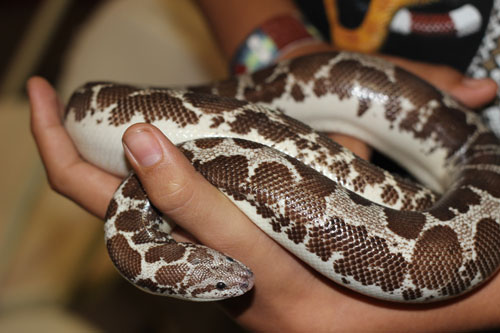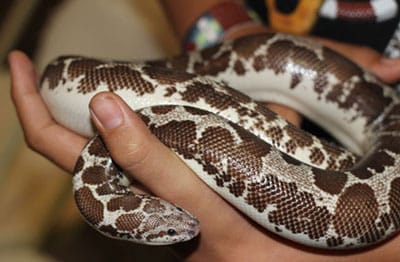Eryx colubrinus is easy to keep, breed readily in captivity and come in a variety of morphs.
The Kenyan sand boa (Eryx colubrinus) is a stout little snake indigenous to Kenya, Egypt, Sudan, Tanzania, western Libya, Ethiopia, Chad, Yemen, Niger and northern Somalia. It is also referred to as the East African sand boa because its geographical origin is not limited to Kenya.
It is naturally variable in color and pattern, with the background color ranging from orange to yellow, and patterned with intricate chocolate-brown to black blotches. I often relate the pattern of Kenyans to snowflakes or fingerprints – they look the same, but no two are identical.
Read More

John Virata/Snake courtesy brotherboas.com
Kenyan sand boas are easy to keep, breed readily in captivity and come in a variety of morphs.
Even the eyes have a similar mottled pattern and coloration as the dorsal surface of the body, presumably to aid in camouflage. Small and set high on the head, a sand boa's eyes no doubt make it easier for the snake to spot both prey and predators. The ventral surface and lower sides are patternless white or cream-colored. There are also plenty of interesting color and pattern anomalies being produced by breeders. Some of the available morphs, many of which can be seen in the photos accompanying this article, include albino, anerythristic, snow, paradox, nuclear, high-yellow, reduced pattern, striped, peppered and tigers. Excess yellow or orange coloration may be indicative to the geographic origin of individual animals, but it is possible to selectively breed them to bring out a desired color intensity.
Born to Burrow
The Kenyan sand boa's head shape is distinctive and perfectly designed for a burrowing snake, with a flattened appearance and pointed nose. There is an enlarged rostral scale extending over the lower jaw that allows the snake to burrow with ease. It's fascinating to watch a sand boa "swimming" through loose substrate.
Tunneling under the terrain in its natural habitat is a way for it to evade predators, stalk prey and regulate body temperature. Some keepers feel the disadvantage to keeping a sand boa for a pet is that it often stays out of sight, although adults make frequent daily appearances once established and comfortable in their environment.
A wild sand boa in need of a quick defense can rely on its extraordinary tail, which is stout and covered with file-like scales. These rough, heavily keeled scales would be a challenge for ravenous teeth or beaks to penetrate. The fact that the armored tail appears remarkably similar to the snake's head also creates confusion. A predator will often target the head or the tail of a snake, but in the case of a sand boa, it may be left trying to figure out which end is which.
Kenyan Sand Boa Size
Kenyan sand boas are sexually dimorphic, an unusual characteristic among snakes in general. In this species, size makes the difference.
Full-grown males are almost always less than two-thirds the size of adult females. Males tend to average 16 to 18 inches, occasionally exceeding 20 inches. Females will max out at approximately 2 feet, seldom surpassing 21/2 feet in length.
Neither sex is exactly slender, but the females have the heftier girth of the two. It's also pretty easy to determine the gender of a Kenyan sand boa by comparing tail shape. The male has a longer, slimmer tail, whereas the female's tail is stubbier and shorter.
Like most reptiles, Kenyan sand boas are long-term pets. There are some longevity reports of more than 30 years. I have two females in my collection that have been with me for almost 20 years, and they were both at least 2 years old when I acquired them. One of those females is still breeding, but her production has slowed during the past few years, so I plan to retire her from the program this season. The other simply stopped producing about five years ago. Both appear to be in excellent condition, with good weight and normal behaviors. From my experience, I would conclude the reproductive succession of a healthy female Kenyan sand boa in captivity should reach 15 years or beyond.
The Kenyan sand boa usually feeds with gusto in captivity, and problem feeders are rare. I feed my adult females weekly and my males every 10 to 14 days. Females are offered one frozen-thawed adult mouse, and my males get one frozen-thawed hopper mouse. Rats of appropriate size are perfectly acceptable, as well.
It is not unheard of for adult male Kenyan sand boas to feed sporadically. I have only encountered one male with this peculiar habit, only taking food every few months. He was still healthy, with good weight, and he bred like a champ. All of my other males eat right on schedule, unless they are in a shed cycle. Kenyan sand boas that are shedding will often strike and constrict their meal, but then abandon it.
I always offer dead prey with 12-inch metal tweezers. My sand boas will predictably grab and constrict a mouse, oblivious to the fact that the rodent is already dead.
One of the only obstacles you will face when obtaining a new baby sand boa, is its preference for live prey. A large percentage of the babies I produced start off on live pinky mice. Fortunately, this is only temporary. With a little bit of effort and patience, you can encourage a baby Kenyan to accept a dead pinky by wiggling it in front of the snake's face, or by dragging the pinky across the surface of the substrate. This method of tease-feeding usually only takes a few tries to be successful.
Compact Setup
Especially appealing to me, and many keepers, is the minimal space requirements of the Kenyan sand boa. The average adult can be comfortably housed in a 10-gallon aquarium or similarly sized enclosure with a secure lid. A 20 gallon is better for jumbo-sized females, but typical full-grown specimens will not require anything larger than a 10 gallon. A plastic storage container of appropriate dimensions, along with air holes, will also work well in a heated shelving unit. The plastic units I use are approximately 23 inches long, 15 inches wide and 6 inches tall. The spaces in a rack system must be tight, as sand boas may have little trouble pushing the lid off of a plastic container if space allows.
I have kept sand boas in aquariums in the past, with no problems at all, but I prefer to use a plastic sweaterbox rack system currently. This saves cleaning time and space, and I find this method more efficient to heat. If a glass terrarium with a screen lid is used, I recommend using both an under-tank heating pad beneath one side of the cage, left on 24/7, along with an incandescent overhead lamp during the day, to heat the air in the tank. It's also imperative to keep on top of the shed cycle with this type of enclosure, and increase the humidity accordingly, as moisture will be easily lost through the screen lid. This is easily accomplished by employing a good old-fashioned spray bottle, once or twice a day during the shed cycle.
Snakes in general are solitary creatures. For this reason, along with cleaning efficiency and more accurate record keeping, I prefer to keep them individually. In the past, I have kept Kenyan sand boas communally, with no issues whatsoever, but separating them for feeding is always recommended.
Unlike many other exotic snakes, this species is surprisingly tolerant of temperature fluctuations, which is a bonus for beginners. Ultimately, the hotspot at the main heat source should be approximately 95 degrees Fahrenheit, with a cooler side around 80 degrees. A drop to the mid-70s at night is perfectly acceptable.
A variety of substrates work well with sand boas, not just sand. I have successfully kept and bred mine on many substrates, including aspen bedding, coconut mulch, play sand and even newspaper. I recommend avoiding gravel, corncob bedding and (for all reptiles) cedar shavings.
Given that the Kenyan sand boa is inclined to burrow, cage furniture should be minimal. A traditional hide box will rarely be utilized, but this snake may appreciate upside-down coconut halves, driftwood and some commercially available herp caves. Use sturdy pieces, but avoid heavy rocks unless they are firmly fastened to the enclosure. Flat rocks or pieces of slate or bark along the surface of the substrate may work well for adding extra security, and they will not be easy to topple. If a sand boa burrows beneath heavy rocks and causes a mini-avalanche, the result could be injury or even death to the animal.
Despite its small size, a Kenyan sand boa can be very destructive to your interior design. Decorative branches are a nice touch, but will only be there for your enjoyment. This is a terrestrial snake, preferring to spend much of its time underground or on the surface. Climbing is not part of its usual routine. A ceramic bowl large enough to drink from but not big enough to soak in will be a good choice for a water dish. Make sure it is sturdy. A light, plastic water dish will be easy for the snake to topple over, possibly fouling the environment.
When handling your Kenyan sand boa, take care to provide adequate support. The body is proportionately heavy in contrast to its diminutive length. It's never a good idea to try to rest one of these snakes on your shoulders, as some people do with other types of snakes. Kenyan sand boas are not skilled climbers, and there is a risk of serious injury or worse if one were to fall from that height.
Most of the Kenyan sand boas I have worked with have been even-tempered. I have encountered a few that were feistier than normal, but they preferred to try to get away or twitch, rather than bite. In fact, all bites I have received from Kenyan sand boas have been due to feeding responses from the snake and failure to pay proper attention on my part.
When picking a Kenyan sand boa up, do so from the middle of the body, giving the snake a chance to figure out that you are not on the menu. If you approach the snake from above, near the front third of its body, you may trigger a feeding response and end up with a snake attached to your hand. A sand boa bite is no more severe than a housecat scratch, but it can still be painful for you and traumatic for the snake, and a bite should be avoided.
A Solid Choice
Kenyan sand boas are easy to keep, breed readily in captivity and come in a variety of morphs. Given their compact size, they do not require a lot of room or an elaborate enclosure. For the hobbyist who enjoys having a hardy, beautiful pet snake, it's hard to top a Kenyan sand boa. REPTILES
Darren Boyd is a professional musician, herpetoculturist and all-around troublemaker. He founded his reptile breeding and education-based business, The Reptile Rainforest, in 1995. Visit him online at reptilerainforest.com and darrenboyd.com.


